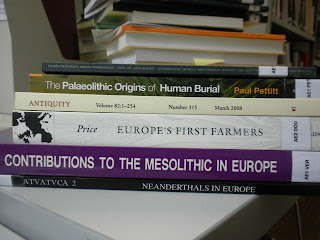That’s pretty provocative, eh? I spent six hours at the Neanderthal Museum’s research library trying to wrap my head around the disappearance of an entire species of human. I also researched stuff about early farming, art, and culture connected to the Neolithic Revolution, but let’s face it, it was the Neanderthal that brought me here all the way from Rochester, New York! In recent years, the pendulum has begun to swing back to the center in terms of understanding the Neanderthal.
First, he (I know, I know, there were hes and shes, but for the sake of consistency, it’s a he) was a savage, brow-ridden brute who was only a step up from homo erectus. But something funny happened in the 70’s; he became a gentler, more capable hominid. Apparently our interpretation of his life was being viewed through the rose-colored glasses of the Flower Power generation. They buried their dead with flowers! They took care of the elderly! They avoided conflict with invading Cro-Magnons (you know, those other humans!). By the late 1990s/ 2000s, genetic forensics and more advanced artifact dating techniques presented a slightly different Neanderthal.
Now we see a human species, successful for some 400,000 years draw the evolutionary short straw. They weathered climate change before, but the collapse of the last interglacial was severe and sudden (geologically speaking) and the Neanderthal had a harder time adapting to the new changes. They were on the cusp of the next step in stone tool manufacturing (sometimes called Micoquian technology, the transition to smaller flint blades and full bi-faced points) but along came someone else with real high tech: Cro-Magnons, or homo sapiens.
Actually, the two had apparently coexisted for some 50,000 years at the edge of the Levant (eastern Mediterranean basin) before a population boom of modern humans forced their kind north and east. When they moved, they moved in tight groups, communicating, leaving symbols about the kinds of animals and places they will find. They developed language and advanced planning. The Neanderthals had never seen anything like this and while a few scientists believe Neanderthals were more in the flee camp of fight vs. flight, the confrontations were no doubt a mismatch as nimble humans could outrun, outhunt, and outwit Neanderthals. Modern humans soon began to fracture Neanderthal ranges and hunting grounds, claiming the best rock shelters for themselves, forcing Neanderthals to higher elevations (with fewer big game animals). They became isolated in pockets too widely dispersed and like any species with a shattered habitat, species continuation becomes problematic. Add the arrival of advanced humans with climate change and the lack of suitable mates, and you have a recipe for extinction.
A little light reading...
There’s more and it will weave its way into a Learning Expedition at some point, but the breadth and depth of research done in the last 20 years is pretty astounding. Oh, and for the record, pop science may say that the Neanderthal DNA is floating around in us, but the folks that sequenced the Neanderthal genome say its more likely due to natural selection and mutation than hybridization – although nature works in funny ways. All in all a fascinating day and I am hugely indebted to Kerstin Pannhorst at the Neanderthal Museum for getting me set up and trusting me to have full run of the research library as well as finding books that might help me. Vielen Dank!


I found your entry so intriguing that I did a little "light research" on my own and checked out a National Geographic article online. It's fascinating to learn that, in addition to limited science and flawed analysis, societal beliefs have impacted scholarly views about Neanderthal through time.
ReplyDelete